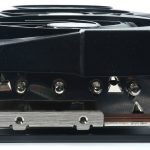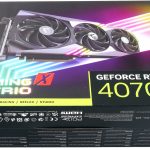I already wrote a few lines about the so-called MSRP cards and the rather annoying cost-down. With the GeForce RTX 4070 Gaming X Trio, MSI brings the exact opposite design to the market, where they pretty much do everything right within the financial balancing act. A solid cooling solution, which we already know from the RTX 4070 Ti, a better and, above all, more completely equipped PCB and rather unimportant things like RGB (which one gladly takes, though). And I want to spoil in advance that a better PCB layout not only increases the efficiency at the same clock rate, but also positively influences the overall picture like heat development and cooling.
The current street price is around 719 Euros, which is about 50 Euros above the MSRP. Yes, the price is not really a groundbreaking special offer, but it could have been worse. In contrast to the cheaper versions at the RRP, the customer finally gets a sophisticated product without the already criticized drawbacks. Without wanting to reignite the price discussion, this 50 euro surcharge is money well spent, because it almost completely reaches the customer, even from a technical point of view.
The manufacturer sets the power limit to 215 watts by default, which is completely justified. Let’s remember my launch article, where even the much more inefficient NVIDIA RTX 4070 FE never got above 215 watts despite the 220 watts maximum power limit. The fact that MSI has set the sweet spot here is definitely no coincidence. You are allowed up to 240 watts, which this card can also safely dissipate as waste heat, but you will never need it. The RTX 4070 Ti will never be reached with a crowbar and the good scaling of TBP and clock rate is lost from 215 watts upwards. That’s why I save myself this effort today, because it now doesn’t go much above 3 GHz, no matter how much resources you press to the grill.
Of course, as usual, there is the comprehensive teardown, an extensive board and cooler analysis with some reverse engineering, as well as the analysis of the power consumption and the load peaks including a suitable power supply recommendation. Since I know that many colleagues will also repeat all the technical details including theory, which have already been presented in various tidbits, I’ll spare myself that today on a large scale and only briefly refer to the already known data. In terms of benchmarks, I refer here to the 220-Watt variant from my launch review, because both cards, both the MSI RTX 4070 Gaming X Trio and NVIDIA’s Founders Edition are within a tolerance range of less than 1% here. These are measurement errors that can be safely ignored.
The AD 104 and the new Ada architecture
The 294.5 mm² chip of the NVIDIA GeForce RTX 4070 is also manufactured in the TSMC 4N process and has 35.8 billion transistors. The AD104-250 still has four Graphic Processing Clusters (GPC) and 46 new Streaming Multiprocessors (SM) with 5888 CUDA cores, whose performance and energy efficiency have increased significantly compared to Ampere. In addition, there are 184 tensor cores of the 4th generation. Generation and Optical Flow, enabling transformative AI technologies including NVIDIA DLSS and the new NVIDIA DLSS 3 frame rate multiplier.
The 46 RT cores of the 3rd generation The new generation offers up to 2x ray tracing performance, Shader Execution Reordering (SER) improves ray tracing operations by a factor of two. In addition, there are a total of 23 Texture Processing Clusters (TPC), 184 Texture Units (TU) and 64 ROPs. The L2 cache is 36864 KB in total and the card, like the GeForce RTX 4070 Ti, uses the familiar 12 GB GDDR6X clocked at 10500 MHz on a rather narrow 192-bit interface, which corresponds to a data rate of 21 Gbps and a bandwidth of 504 GB/s. The AD104-250 of the GeForce RTX 4070 only offers one NVDEC (decoder) instead of four and a single NVENC (encoder). The AV1 encoder is said to be up to 40% more efficient than H.264.
The MSI GeForce RTX 4070 Gaming X Trio 12 GB in detail
The card weighs only 1216 grams, which is about 200 grams more than the compact FE. The length of 33.7 cm is already quite expansive and the height of 13 cm is also clearly above normal. Since you already need a little more space housing, especially also because must use great 12VHPWR adapter. The installation depth is 4.2 cm plus the 5 mm for the backplate on the rear. This makes it a 2.5-slot card.
The design language of the fan, cover and slot bezel is not new, but is in line with the trend of MSI’s Trio X series. MSI uses a single BIOS and those who want to overclock have to use a suitable tool. The feel is high-quality as usual, despite the anthracite-gray plastic cover. This is at least lightened up by RGB LED applications, whereby the MSI lettering including logo on the upper side is also illuminated and can be controlled separately. At least, if the wiring is anything to go by.
The card still relies on a PCIe Gen. 4 interface and only for the external power connection with the 12VHPWR connector (12+4 pin) on an element of the PCIe Gen. 5 specification. The preset TBP is 215 watts and can also be raised up to 240 watts, depending on the request (which is rather pointless because the voltage limits at some point anyway). This is also the reason why you can’t use 8-pin connectors anymore. I think it’s a shame, but that’s just the way the rules of standardization are.
But you can not only put power into the card, but also video connections. There are four of them, to be quite precise, as there are: three times DisplayPort 1.4a and once HDMI 2.1a. That is especially a pity for the DisplayPort when it comes to the new specifications. Opportunity missed, unfortunately. And with HDMI, you have to trick with the compression from 4K onwards if you want it to go above 120 Hz.
The screenshot from GPU-Z shows us default settings of the RTX 4070, which are identical for all 200-Watt cards:
With this, the first page is finished and we are slowly preparing for the test. For the forgetful or newcomers, I’ve also linked to the launch article again, which offers more details and my comments on the MSRP cards:
- 1 - Introduction, technical data and technology
- 2 - Test system and methods
- 3 - Teardown: PCB, components and cooler
- 4 - Gaming performance
- 5 - Details: Power consumption and load balancing
- 6 - Transients and PSU recommendation
- 7 - Colock rate, temperatures and thermal imaging
- 8 - Fan speed and noise level
- 9 - Summary and conclusion























































70 Antworten
Kommentar
Lade neue Kommentare
Urgestein
1
Urgestein
Urgestein
1
1
Urgestein
1
Urgestein
Urgestein
Urgestein
Urgestein
Urgestein
1
Urgestein
Urgestein
Urgestein
Mitglied
Urgestein
Alle Kommentare lesen unter igor´sLAB Community →